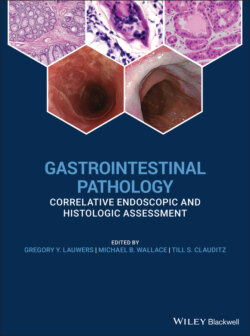Читать книгу Gastrointestinal Pathology - Группа авторов - Страница 99
Clinical and Endoscopic Characteristics
ОглавлениеEndoscopic evaluation often plays a central role in the evaluation of patients with suspected esophageal manifestations of these dermatologic diseases, although in some cases the procedure must be approached with caution, particularly in the bullous or blistering disorders.
Figure 2.22 Endoscopic appearance of esophageal lichen planus with diffuse mucosal plaques.
In lichen planus, dysphagia and esophageal strictures may clinically suggest GERD. Magnification chromoendoscopy was used in one study showing a high prevalence of esophageal disease. Mucosal stripping, hyperemia, and submucosal plaques (Figure 2.22) are typically limited to the upper and mid‐esophagus.
Odynophagia and dysphagia are the usual symptoms of esophageal pemphigus vulgaris, as well as the other mucosal blistering diseases. Endoscopic diagnosis involves both evaluation of the appearance of the lesions and tissue sampling. The mucosa may initially appear normal, with the subsequent appearance of erosions, diffuse longitudinal erythematous lines, or mucosal sloughing. Induction of bullae in normal mucosa by the endoscope (Nikolsky's sign) may be observed.
The esophagus is among the most common sites of GI involvement in epidermolysis bullosa, manifested by symptoms of dysphagia and odynophagia. Clinical phenotypes range from mild to severe with bullae and blister formation, ulceration, scarring, webs, and strictures, most commonly involving the proximal esophagus. The trauma of a food bolus, or the endoscope itself, may precipitate of exacerbate bullae and ulcer formation.
